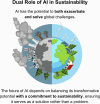Radiology AI and sustainability paradox: environmental, economic, and social dimensions
- PMID: 40244301
- PMCID: PMC12006592
- DOI: 10.1186/s13244-025-01962-2
Radiology AI and sustainability paradox: environmental, economic, and social dimensions
Abstract
Artificial intelligence (AI) is transforming radiology by improving diagnostic accuracy, streamlining workflows, and enhancing operational efficiency. However, these advancements come with significant sustainability challenges across environmental, economic, and social dimensions. AI systems, particularly deep learning models, require substantial computational resources, leading to high energy consumption, increased carbon emissions, and hardware waste. Data storage and cloud computing further exacerbate the environmental impact. Economically, the high costs of implementing AI tools often outweigh the demonstrated clinical benefits, raising concerns about their long-term viability and equity in healthcare systems. Socially, AI risks perpetuating healthcare disparities through biases in algorithms and unequal access to technology. On the other hand, AI has the potential to improve sustainability in healthcare by reducing low-value imaging, optimizing resource allocation, and improving energy efficiency in radiology departments. This review addresses the sustainability paradox of AI from a radiological perspective, exploring its environmental footprint, economic feasibility, and social implications. Strategies to mitigate these challenges are also discussed, alongside a call for action and directions for future research. CRITICAL RELEVANCE STATEMENT: By adopting an informed and holistic approach, the radiology community can ensure that AI's benefits are realized responsibly, balancing innovation with sustainability. This effort is essential to align technological advancements with environmental preservation, economic sustainability, and social equity. KEY POINTS: AI has an ambivalent potential, capable of both exacerbating global sustainability issues and offering increased productivity and accessibility. Addressing AI sustainability requires a broad perspective accounting for environmental impact, economic feasibility, and social implications. By embracing the duality of AI, the radiology community can adopt informed strategies at individual, institutional, and collective levels to maximize its benefits while minimizing negative impacts.
Keywords: Artificial intelligence; Environmental health; Health equity; Radiology; Sustainability.
© 2025. The Author(s).
Conflict of interest statement
Declarations. Ethics approval and consent to participate: Not applicable. Consent for publication: Not applicable. Competing interests: A.P. is a member of the Scientific Editorial Board of Insights into Imaging; he did not take part in the review or selection processes of this article. M.H.: unrelated to this manuscript: Speakers honoraria from industry (DeepC, Bayer, Canon, Sonoskills); paid consulting (Capvision); support for attending meetings and/or travel from scientific societies; EuSoMII Board member, ESR eHealth & Informatics Subcommittee member, ECR Imaging Informatics/Artificial Intelligence and Machine Learning Chairperson 2025, committee member with FMS (Dutch), and Radiology: Artificial Intelligence associate editor and trainee editorial board advisory panel (all unpaid). The other authors have nothing to disclose.
Figures












Similar articles
-
Artificial Intelligence, the Digital Surgeon: Unravelling Its Emerging Footprint in Healthcare - The Narrative Review.J Multidiscip Healthc. 2024 Aug 15;17:4011-4022. doi: 10.2147/JMDH.S482757. eCollection 2024. J Multidiscip Healthc. 2024. PMID: 39165254 Free PMC article. Review.
-
Revolutionizing Radiology With Artificial Intelligence.Cureus. 2024 Oct 29;16(10):e72646. doi: 10.7759/cureus.72646. eCollection 2024 Oct. Cureus. 2024. PMID: 39474591 Free PMC article. Review.
-
Environmental Sustainability and AI in Radiology: A Double-Edged Sword.Radiology. 2024 Feb;310(2):e232030. doi: 10.1148/radiol.232030. Radiology. 2024. PMID: 38411520 Free PMC article. Review.
-
Rogue AI: Cautionary Cases in Neuroradiology and What We Can Learn From Them.Cureus. 2024 Mar 17;16(3):e56317. doi: 10.7759/cureus.56317. eCollection 2024 Mar. Cureus. 2024. PMID: 38628986 Free PMC article.
-
Climate change and artificial intelligence in healthcare: Review and recommendations towards a sustainable future.Diagn Interv Imaging. 2024 Nov;105(11):453-459. doi: 10.1016/j.diii.2024.06.002. Epub 2024 Jun 24. Diagn Interv Imaging. 2024. PMID: 38918123 Review.
Cited by
-
Emergency radiology: roadmap for radiology departments.Jpn J Radiol. 2025 Jun 20. doi: 10.1007/s11604-025-01819-0. Online ahead of print. Jpn J Radiol. 2025. PMID: 40540107 Review.
References
-
- Khalifa M, Albadawy M (2024) AI in diagnostic imaging: revolutionising accuracy and efficiency. Comput Methods Prog Biomed Update 5:100146. 10.1016/j.cmpbup.2024.100146
-
- Kocak B, Baessler B, Cuocolo R et al (2023) Trends and statistics of artificial intelligence and radiomics research in radiology, nuclear medicine, and medical imaging: bibliometric analysis. Eur Radiol 33:7542–7555. 10.1007/s00330-023-09772-0 - PubMed
-
- Joshi G, Jain A, Araveeti SR et al (2024) FDA-approved artificial intelligence and machine learning (AI/ML)-enabled medical devices: an updated landscape. Electronics 13:498. 10.3390/electronics13030498
-
- Muehlematter UJ, Bluethgen C, Vokinger KN (2023) FDA-cleared artificial intelligence and machine learning-based medical devices and their 510(k) predicate networks. Lancet Digit Health 5:e618–e626. 10.1016/S2589-7500(23)00126-7 - PubMed
LinkOut - more resources
Full Text Sources
Miscellaneous

